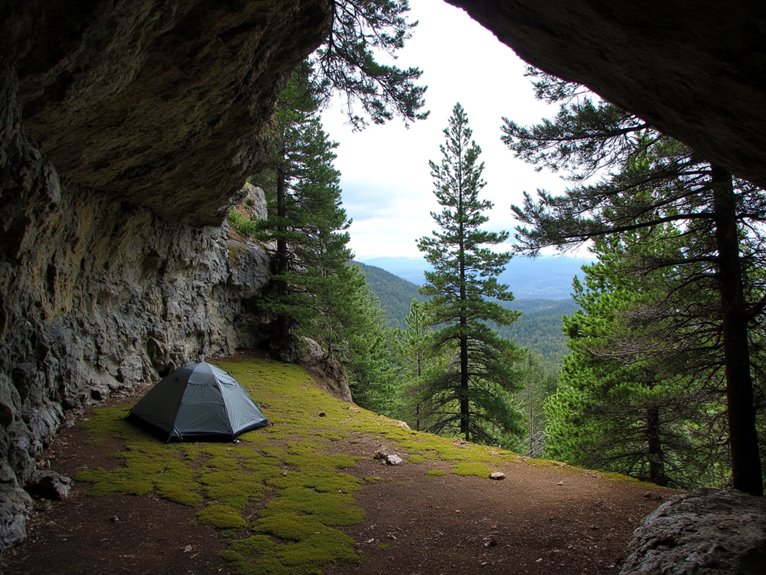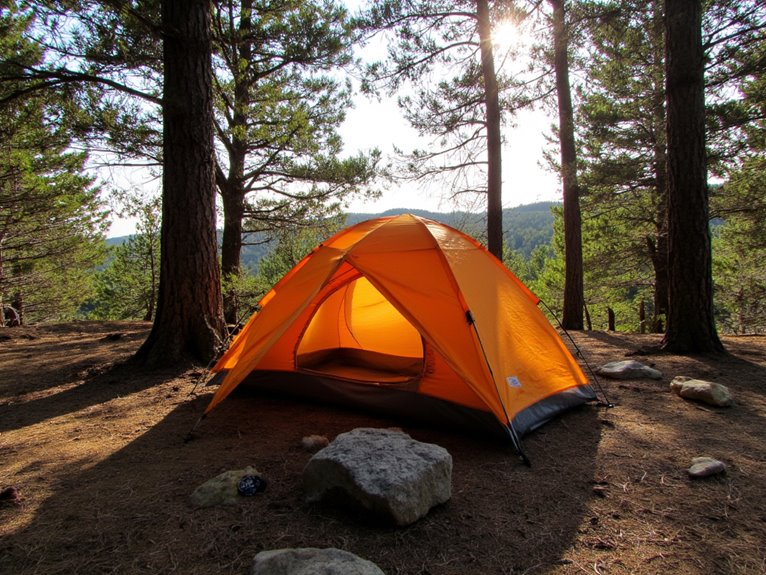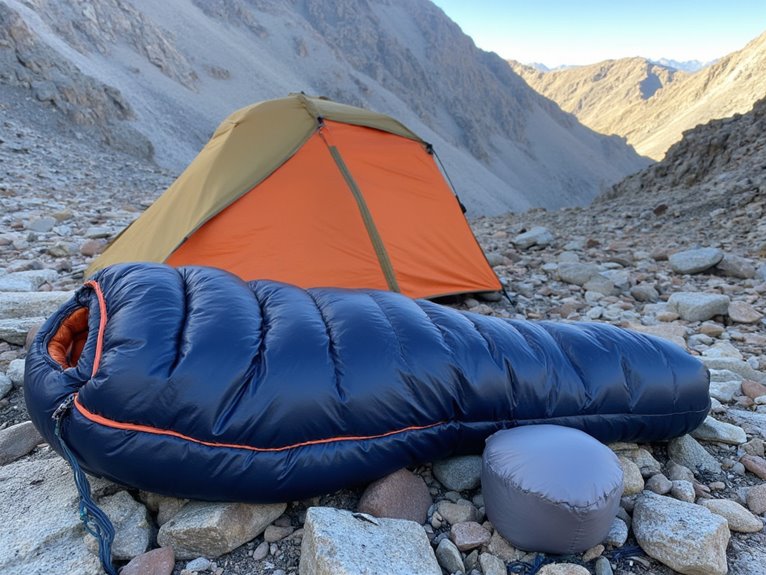How to Choose and Prepare a Campsite for Better Sleep
Choose level ground with slopes under 3-5 degrees to prevent rolling and guarantee proper drainage. Look for areas with 70-80% vegetation coverage and firm soil that’ll hold your tent stakes securely. Position your tent behind natural windbreaks like hills or dense trees, with the door facing away from prevailing winds. Maintain 200 feet from high-traffic areas and store food 100+ feet from your sleeping area for safety. Clear debris and rocks before setting up. The following strategies will maximize your overnight comfort and protection.
We are supported by our audience. When you purchase through links on our site, we may earn an affiliate commission, at no extra cost for you. Learn more. Last update on 5th December 2025 / Images from Amazon Product Advertising API.
Notable Insights
- Choose flat, stable grass terrain with 70-80% vegetation coverage and minimal slope to ensure comfort and prevent erosion.
- Position your tent behind natural windbreaks like hills or dense trees while avoiding flood-prone valleys and unstable rock formations.
- Orient tent door away from prevailing winds and place your head slightly uphill to improve airflow and circulation.
- Maintain 200+ feet distance from high-traffic areas and use natural sound barriers like streams or dense vegetation.
- Store food 100+ feet from sleeping area and keep emergency supplies accessible to ensure safety throughout the night.
Selecting Level Ground and Assessing Terrain Quality
Five critical terrain factors determine whether you’ll wake up refreshed or spend the night sliding downhill in your sleeping bag.
First, analyze slope gradients exceeding 3-5 degrees, which create uncomfortable sleeping angles and potential runoff issues. Terrain stability depends on solid substrate composition—avoid loose rock formations, soft soil patches, or areas with visible erosion patterns.
Your soil assessment should identify ground surface types systematically. Grass provides excellent cushioning and drainage, while exposed dirt or rock surfaces offer poor comfort.
Check for organic litter coverage, as bare soil indicates potential instability and erosion risk. Vegetation density directly correlates with ground stability—areas with 70-80% vegetative cover typically provide superior support.
Water flow patterns require careful evaluation. Avoid depressions, drainage channels, or flood-prone areas within 100 feet of water sources.
Evaluating Weather Protection and Natural Shelter

While terrain quality forms your campsite’s foundation, weather protection determines whether you’ll stay dry and comfortable throughout the night.
Effective wind protection requires positioning your tent behind natural barriers like hills or dense tree groves. These features can reduce wind speeds by 40-60% compared to exposed areas.
Rain shelter evaluation focuses on tree canopies and rock overhangs that deflect precipitation. Dense forest canopies provide moderate protection but aren’t foolproof during heavy downpours. Rock formations offer superior wind blocking but limited overhead coverage.
Avoid flood-prone areas near streams or low-lying valleys where water accumulates. Position your campsite on stable, well-draining soil that won’t erode during rainfall.
Natural windbreaks should be sturdy enough to withstand expected weather conditions without compromising your safety.
Identifying and Avoiding Safety Hazards
After establishing weather protection, you must systematically assess potential safety hazards that could transform a restful night into a dangerous situation.
Your campsite evaluation requires examining terrain stability, wildlife activity patterns, and environmental risks that threaten sleep quality and personal safety.
Execute this three-step hazard assessment protocol:
- Survey terrain for geological instability – Avoid areas below loose rock faces, steep slopes prone to landslides, or flood-prone valleys near water sources.
- Implement thorough wildlife precautions – Store food in bear-proof containers 100+ feet from sleeping areas and eliminate scented items that attract animals.
- Position emergency supplies strategically – Place first aid kits, communication devices, and evacuation tools within arm’s reach of your sleeping area.
This systematic approach prevents the 30,000+ annual camping injuries while ensuring uninterrupted rest.
Positioning Your Tent for Optimal Comfort

Once you’ve secured your campsite from hazards, proper tent orientation becomes the cornerstone of achieving restorative sleep in the outdoors.
Position your tent door away from prevailing wind direction to minimize structural strain and noise. Orient the entrance downwind to prevent precipitation from entering your shelter.
Select flat or gently sloping terrain with your head positioned slightly uphill. This prevents blood pooling and maintains circulation during sleep.
Check ground firmness for secure stake placement and tent stability.
Align ventilation opposite wind direction for cross-airflow that reduces condensation buildup. Face doors away from early morning sun to prevent overheating.
Use natural windbreaks like trees or hills while maintaining adequate airflow. Position doors toward scenic views for morning comfort while ensuring privacy from neighboring campers and trail access points.
Preparing the Sleeping Surface and Clearing Debris
Three critical ground preparation steps determine whether you’ll wake refreshed or sore after a night outdoors.
Proper debris removal creates the foundation for comfortable sleep. Clear all sticks, rocks, and pinecones within a six-foot radius of your tent footprint. Even small objects become pressure points that’ll dig into your back through thin sleeping pads.
- Remove all surface debris including stones larger than one inch, fallen branches, and organic matter like pinecones or acorns that create uneven pressure points.
- Perform thorough surface smoothing using a rake or camp shovel to level the ground, filling small depressions with loose soil or sand.
- Install protective ground covering by placing a durable tarp or footprint beneath your tent to shield against moisture and remaining sharp objects.
This methodical approach prevents discomfort and equipment damage.
Managing Noise and Disturbance Factors
When selecting your campsite, you’ll want to position yourself strategically to minimize noise disturbances that can disrupt sleep quality.
Look for natural sound barriers like dense tree stands, rock formations, or hillsides that can absorb and deflect unwanted sounds from nearby campers or environmental sources.
Maintaining at least 200 feet of distance from high-traffic areas such as main walkways, restrooms, and camp roads will greatly reduce the audible impact of foot traffic and vehicle noise throughout the night.
Natural Sound Barriers
While most campers focus on tent placement and gear selection, the acoustic environment of your campsite directly impacts sleep quality through measurable sound reduction techniques.
Strategic positioning near natural features provides significant sound absorption benefits. Dense vegetation and topographic barriers deflect noise waves before reaching your sleeping area. Portable plant walls with broad leaves reduce ambient noise by 8-10 decibels, while flowing water sources create consistent background masking.
- Position your site near streams or brooks – flowing water generates 40-50 decibel ambient sound that masks external disturbances and promotes deeper sleep cycles.
- Deploy portable vegetation barriers – arrange 5-7 potted plants with dense foliage around your perimeter for up to 5 decibel noise reduction.
- Utilize natural topography – camp near hills, rock formations, or tree clusters that deflect sound waves away from your tent.
These methods create measurable campsite tranquility through proven acoustic principles.
Distance From Traffic
Traffic noise ranks as the single most disruptive factor in campsite acoustics, with studies showing camper annoyance ratings consistently exceeding 4 on a 5-point scale.
You’ll find that road proximity doesn’t always predict actual noise impact due to terrain variations, wind patterns, and vegetation effects. Even campsites positioned considerable distances from highways can experience clear intrusion from heavy traffic and emergency sirens, particularly during nighttime hours.
Distance creates your primary defense against traffic disturbance.
Position your tent toward the campground’s interior, away from access roads and highway corridors. Direct line-of-sight to traffic considerably amplifies noise impact regardless of intervening distance. Choose sites behind natural rises or terrain features that block sound transmission.
Experienced campers report higher sensitivity to traffic noise, making distance selection even more critical for quality sleep outcomes.



